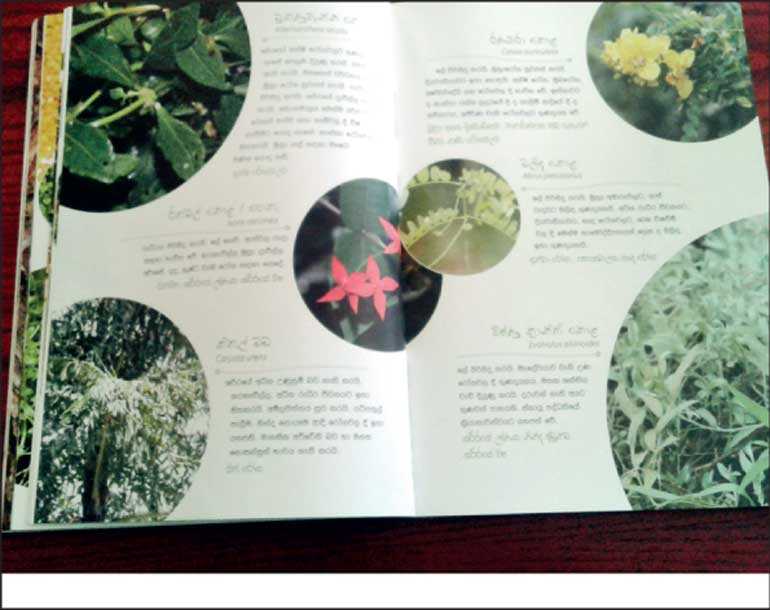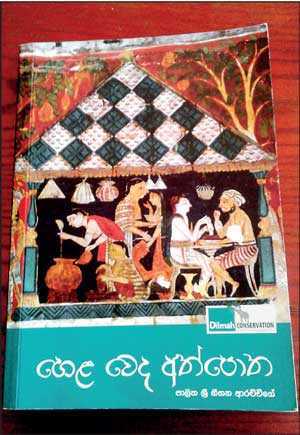Tuesday Apr 22, 2025
Tuesday Apr 22, 2025
Saturday, 3 October 2020 00:00 - - {{hitsCtrl.values.hits}}

 Kenda (traditional Sri Lankan broth) is synonymous with the traditional diet of Sri Lanka and there are kenda types that vary from those using our herbal leaves that are known as ‘kola kenda’ and those using garlic or only rice (roasted kekulu haal) and referred to as ‘dry kendha’ (viyali kendha).
Kenda (traditional Sri Lankan broth) is synonymous with the traditional diet of Sri Lanka and there are kenda types that vary from those using our herbal leaves that are known as ‘kola kenda’ and those using garlic or only rice (roasted kekulu haal) and referred to as ‘dry kendha’ (viyali kendha).
The rice that is advised in the book to be used is red Nivudu variety which has to be kept soaked for a while and then pounded in a wangediya. Separately small red onions, garlic, ginger (amu inguru) should be finely chopped and boiled with the rice. This should be boiled very well. The leaves need to be well-washed and cleaned and pounded well for the juice to be separated. Once again the leaf extracts should be pounded along with the scraped coconut and the juice of this too added to the juice already extracted. This, along with the coconut milk should be added to the rice after it is well-boiled. It is best to switch off the cooker soon after adding the leaf extract so as to retain its nutrition. Why coconut is used in the broth is to ensure that the Carotene levels of the leaves are not evaporated. The coconut absorbs and helps retain this vital nutrition within the liquid. Diya lunu (salt) should be added to the kenda.
Last two weeks we featured several varieties of kenda including Lunu Kenda, Pori Kenda, Badi Haal Kenda, Polkiri Kenda, Kiri Kenda, and diverse varieties of Kola Kenda where the health benefit of the different leaves were cited.
This week we feature kenda (broth) made from the following;
Mukunuwenna leaves, Rathmal leaves/bark, Kithul, Ranawara kola, Olinda kola, Vishnu Kanthi leaves.
Mukunuwenna leaves (Alternanthera Sessils)
Among its uses are improving eyesight, increasing appetite, promoting hair growth, curing urine tract related diseases. It also purifies blood, reduces burning sensation in the body, used to remove animal based poison from the body including snake venom and diseases associated with women.
Rathmal leaves/bark (Ixora Coccinea)
Among its uses are as a blood purifier, for diseases associated with eyes, nerve related instability of body, skin related ailments and burning sensation of the body.
Kithul tree core (Caryota Urens)
As treatment for cooling the body and healing ailments caused by excess heat in the body, insomnia and mental unrest.
Ranawara leaves (Cassia Auriculata)
Cleans blood, cures urine tract related illnesses and aids in food digestion.
Olinda leaves (Abrus precatorius)
Purifies blood, used for urine infection, diabetes, heart disease, poisonous affliction to the body caused by herbs.
(SV)
Discover Kapruka, the leading online shopping platform in Sri Lanka, where you can conveniently send Gifts and Flowers to your loved ones for any event including Valentine ’s Day. Explore a wide range of popular Shopping Categories on Kapruka, including Toys, Groceries, Electronics, Birthday Cakes, Fruits, Chocolates, Flower Bouquets, Clothing, Watches, Lingerie, Gift Sets and Jewellery. Also if you’re interested in selling with Kapruka, Partner Central by Kapruka is the best solution to start with. Moreover, through Kapruka Global Shop, you can also enjoy the convenience of purchasing products from renowned platforms like Amazon and eBay and have them delivered to Sri Lanka.
Discover Kapruka, the leading online shopping platform in Sri Lanka, where you can conveniently send Gifts and Flowers to your loved ones for any event including Valentine ’s Day. Explore a wide range of popular Shopping Categories on Kapruka, including Toys, Groceries, Electronics, Birthday Cakes, Fruits, Chocolates, Flower Bouquets, Clothing, Watches, Lingerie, Gift Sets and Jewellery. Also if you’re interested in selling with Kapruka, Partner Central by Kapruka is the best solution to start with. Moreover, through Kapruka Global Shop, you can also enjoy the convenience of purchasing products from renowned platforms like Amazon and eBay and have them delivered to Sri Lanka.